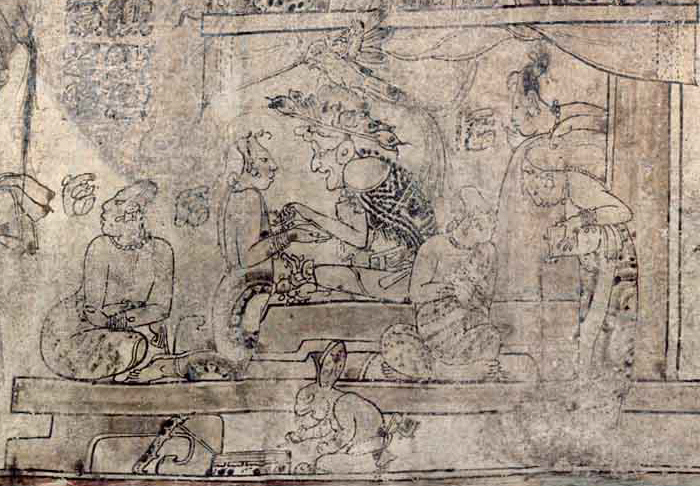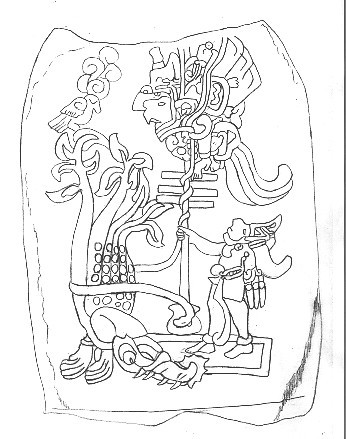|
Maya Mythology
Maya or Mayan mythology is part of Mesoamerican mythology and comprises all of the Maya tales in which personified forces of nature, deities, and the heroes interacting with these play the main roles. The myths of the era have to be reconstructed from iconography. Other parts of Mayan oral tradition (such as animal tales, folk tales, and many moralising stories) are not considered here. Important Early-Colonial and Recent narrative themes In Maya narrative, the origin of many natural and cultural phenomena is set out, often with the moral aim of defining the ritual relationship between humankind and its environment. In such a way, one finds explanations about the origin of the heavenly bodies (Sun and Moon, but also Venus, the Pleiades, the Milky Way); the mountain landscape; clouds, rain, thunder and lightning; wild and tame animals; the colors of the maize; diseases and their curative herbs; agricultural instruments; the steam bath, etc. The following more encompassing themes ... [...More Info...] [...Related Items...] OR: [Wikipedia] [Google] [Baidu] |
Mesoamerica
Mesoamerica is a historical region and cultural area in southern North America and most of Central America. It extends from approximately central Mexico through Belize, Guatemala, El Salvador, Honduras, Nicaragua, and northern Costa Rica. Within this region pre-Columbian societies flourished for more than 3,000 years before the Spanish colonization of the Americas. Mesoamerica was the site of two of the most profound historical transformations in world history: primary urban generation, and the formation of New World cultures out of the long encounters among indigenous, European, African and Asian cultures. In the 16th century, Eurasian diseases such as smallpox and measles, which were endemic among the colonists but new to North America, caused the deaths of upwards of 90% of the indigenous people, resulting in great losses to their societies and cultures. Mesoamerica is one of the five areas in the world where ancient civilization arose independently (see cradle of civ ... [...More Info...] [...Related Items...] OR: [Wikipedia] [Google] [Baidu] |
Dragon
A dragon is a reptilian legendary creature that appears in the folklore of many cultures worldwide. Beliefs about dragons vary considerably through regions, but dragons in western cultures since the High Middle Ages have often been depicted as winged, horned, and capable of breathing fire. Dragons in eastern cultures are usually depicted as wingless, four-legged, serpentine creatures with above-average intelligence. Commonalities between dragons' traits are often a hybridization of feline, reptilian and avian features. Scholars believe huge extinct or migrating crocodiles bear the closest resemblance, especially when encountered in forested or swampy areas, and are most likely the template of modern Oriental dragon imagery. Etymology The word ''dragon'' entered the English language in the early 13th century from Old French ''dragon'', which in turn comes from la, draconem (nominative ) meaning "huge serpent, dragon", from Ancient Greek , (genitive , ) "serpent, giant s ... [...More Info...] [...Related Items...] OR: [Wikipedia] [Google] [Baidu] |
Project Gutenberg
Project Gutenberg (PG) is a Virtual volunteering, volunteer effort to digitize and archive cultural works, as well as to "encourage the creation and distribution of eBooks." It was founded in 1971 by American writer Michael S. Hart and is the oldest digital library. Most of the items in its collection are the full texts of books or individual stories in the public domain. All files can be accessed for free under an open format layout, available on almost any computer. , Project Gutenberg had reached 50,000 items in its collection of free eBooks. The releases are available in Text file, plain text as well as other formats, such as HTML, PDF, EPUB, Mobipocket, MOBI, and Plucker wherever possible. Most releases are in the English language, but many non-English works are also available. There are multiple affiliated projects that provide additional content, including region- and language-specific works. Project Gutenberg is closely affiliated with Distributed Proofreaders, an Inte ... [...More Info...] [...Related Items...] OR: [Wikipedia] [Google] [Baidu] |
Popol Vuh
''Popol Vuh'' (also ''Popol Wuj'' or ''Popul Vuh'' or ''Pop Vuj'') is a text recounting the mythology and history of the Kʼicheʼ people, one of the Maya peoples, who inhabit Guatemala and the Mexican states of Chiapas, Campeche, Yucatan and Quintana Roo, as well as areas of Belize, Honduras and El Salvador. The ''Popol Vuh'' is a foundational sacred narrative of the Kʼicheʼ people from long before the Spanish conquest of the Maya. It includes the Mayan creation myth, the exploits of the Maya Hero Twins, Hero Twins Hunahpú and Xbalanqué, and a chronicle of the Kʼicheʼ people. The name "Popol Vuh" translates as "Book of the Community" or "Book of Counsel" (literally "Book that pertains to the mat", since a woven mat was used as a royal throne in ancient Kʼicheʼ society and symbolised the unity of the community). It was originally preserved through oral tradition until approximately 1550, when it was recorded in writing. The documentation of the ''Popol Vuh'' is credited ... [...More Info...] [...Related Items...] OR: [Wikipedia] [Google] [Baidu] |
List Of Maya Gods And Supernatural Beings
This is a list of deities playing a role in the Classic (200–1000 CE), Post-Classic (1000–1539 CE) and Contact Period (1511–1697) of Maya religion. The names are mainly taken from the books of Chilam Balam, Lacandon ethnography, the Madrid Codex, the work of Diego de Landa, and the Popol Vuh. Depending on the source, most names are either Yucatec or Kʼicheʼ. The Classic Period names (belonging to the Classic Maya language) are only rarely known with certainty. Maya mythological beings List Source Key *CHB – Books of Chilam Balam *LAC – Lacandon ethnography *L – de Landa *M — Madrid Codex *PV – the Popol Vuh. A Acan The god of wine and intoxication, identified with the drink Balché. Acat A god of tattoos and tattooing. Alom The god of the sky and wood, a creator deity. Ah-Muzen-Cab God of bees and honey. Awilix The goddess of the moon, queen of the night. B Bacab The old god of the interior of the earth and of thunder, sky-carrier, fou ... [...More Info...] [...Related Items...] OR: [Wikipedia] [Google] [Baidu] |
University Of Oklahoma Press
The University of Oklahoma Press (OU Press) is the publishing arm of the University of Oklahoma. Founded in 1929 by the fifth president of the University of Oklahoma, William Bennett Bizzell, it was the first university press to be established in the American Southwest. The OU Press is one of the leading presses in the region, and is primarily known for its titles on the American West and Native Americans, though the press publishes texts on other subjects as well, ranging from wildlife to ancient languages.Oklahoma Historical Society's Encyclopaedia of Oklahoma History and Culture Tornadoes and severe weather are another focus. The press releases around 80 books every year. A profile of the University of Oklahoma Press from 2018 quotes OU President David Boren as saying: "The OU Press is one of the crown jewels of the University of Oklahoma.” The Arthur H. Clark Company (founded 1902) was a major printer of publications related to the history of the Western United States. In ... [...More Info...] [...Related Items...] OR: [Wikipedia] [Google] [Baidu] |
Naranjo
Naranjo is a Pre-Columbian Maya city in the Petén Basin region of Guatemala. It was occupied from about 500 BC to 950 AD, with its height in the Late Classic Period. The site is part of Yaxha-Nakum-Naranjo National Park. The city lies along the Mopan and Holmul rivers, and is about 50 km east of the site of Tikal. Naranjo has been the victim of severe looting. The site is known for its polychrome ceramic style "Naranjo" in Spanish means "Orange Tree", which in turn derives from the Mayan name Wak Kab'nal. The emblem glyph of the Naranjo is transliterated as Sa'aal “the place where (maize) gruel abounds.” The Naranjo dynastic rulers are said to be the "Holy Lords of Sa'aal." Layout of site The area of Naranjo covers at least 8 km² with the urban center covering about 2.25 km². There are currently 389 recorded buildings in the central area and over 900 around the center. The epicenter consists of six triadic complexes, two ballcourts, two palace compounds ... [...More Info...] [...Related Items...] OR: [Wikipedia] [Google] [Baidu] |
Maya Jaguar Gods
The pre-Columbian Maya religion knew various jaguar gods, in addition to jaguar demi-gods, (ancestral) protectors, and transformers. The main jaguar deities are discussed below. Their associated narratives (part of Maya mythology) are still largely to be reconstructed. Lacandon and Tzotzil- Tzeltal oral tradition are particularly rich in jaguar lore. The Maya people saw the jaguar's attributes as a strong and powerful creature, as well as its easily recognizable coat, and incorporated it into their mythology. Many gods were portrayed as jaguars, or at least had characteristics not unlike jaguars, due to their powerful nature. The Jaguar God of Terrestrial Fire and War ('Night Sun') The Jaguar God of Terrestrial Fire is recognizable by a 'cruller' around the eyes (making a loop over the nose), jaguar ears, and fangs. He personifies the number seven, which is associated with the day ''Akʼbʼal'' ('Night'). Usually called 'Jaguar God of the Underworld', he has been assum ... [...More Info...] [...Related Items...] OR: [Wikipedia] [Google] [Baidu] |
Izapa
Izapa is a very large pre-Columbian archaeological site located in the Mexican state of Chiapas; it is best known for its occupation during the Late Formative period. The site is situated on the Izapa River, a tributary of the Suchiate River, near the base of the volcano Tacaná, the sixth tallest mountain in Mexico. The settlement at Izapa extended over 1.4 miles, making it the largest site in Chiapas. The site reached its apogee between 850 BCE and 100 BCE; several archaeologists have theorized that Izapa may have been settled as early as 1500 BCE, making it as old as the Olmec sites of San Lorenzo Tenochtitlán and La Venta. Izapa remained occupied through the Early Postclassic period, until approximately 1200 CE. Due to the abundance of carved Maya stelae and monuments at Izapa, the term "Izapan style" is used to describe similarly executed works throughout the Pacific foothills and highlands beyond, including some found at Takalik Abaj and Kaminaljuyu. Izapa is located o ... [...More Info...] [...Related Items...] OR: [Wikipedia] [Google] [Baidu] |
Vucub Caquix
Vucub-Caquix ( quc, Wuqub’ Kaqix, , possibly meaning 'seven-Macaw') is the name of a bird demon defeated by the Hero Twins of a Kʼicheʼ people, Kʼicheʼ-Mayan myth preserved in an 18th-century document, entitled ʼPopol Vuhʼ. The episode of the demon's defeat was already known in the Late Preclassic Period, before the year 200 AD. He was also the father of Zipacna, an underworld demon deity, and Cabrakan, the Earthquake God. The Kʼicheʼ Tale Vucub-Caquix is described as a powerful bird pretending to be the sun and moon of the twilight world in between the former creation and the present one. According to modern Kʼicheʼ, his name refers to the seven stars of the Big Dipper Asterism (astronomy), asterism. The false sun-moon bird was shot out of his tree with a blowgun by Hun-Ahpu, one of the Maya Hero Twins, but still managed to sever the hero's arm. Finally, however, the demon was deprived of his teeth, his eyes, his riches, and his power. Together, the Twins were to become ... [...More Info...] [...Related Items...] OR: [Wikipedia] [Google] [Baidu] |





